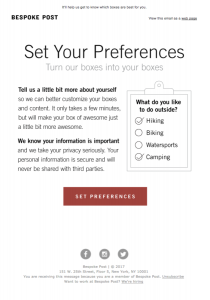Much like how a poor landing for a gymnast can negate a great performance, poor landing pages can have a negative effect on the results of an otherwise flawless marketing campaign. While all the tactics used in a marketing campaign are important, the landing pages used in the campaign are one of the most important. The landing page is often the first contact a prospect has with your company and it is crucial for your page to leave a good first impression and for them to have a positive experience.
Additionally, if you are conducting a pay-per-click campaign, your landing pages play a large role in determining your quality score, which has a huge impact on your account’s performance. Below are recommended best practices for increasing the effectiveness of your landing pages.
Less is More
It may seem like a good idea to try to get as much out of a landing page as you can, but if visitors are overwhelmed with too many options, they are not likely to complete any of them. A landing page should have a single purpose. If you feel like you need to have more, create a separate landing page for each. In addition to only having one purpose, a landing page should only have one call-to-action, corresponding to that page’s specific purpose.
Another element to limit on landing pages is the number of fields in the forms. Studies have shown that conversions increase when visitors are not required to give up as much personal information. Knowing this, it is also important to consider how much information visitors are willing to provide and balance that with what information you truly need. Depending on the number of form fields you decide upon, you can also consider the number of steps a user takes when completing a form. Having all fields on one page or requiring users to select “next” for separate steps gives a different experience. Testing each layout to see which yielded a higher conversion rate might give you an idea of which experience the visitors prefer.
Show Them What You Want
In addition to limiting the call-to-action to only one action, make sure that visitors know what it is that you want them to do. There should be a clear header that clearly instructs the visitor to complete the desired action. The CTA should tell them exactly what will happen when they complete your form or other CTA requirements. Words such as “download,” “subscribe” and “contact us” are useful examples. Ensure the CTA is not too difficult to locate. Having the form or click button at a well-seen location can allow visitors to easily access and perform a conversion. Ideally, this will be the first thing that draws their attention when they visit the page. Graphic elements such as arrows, colors and call-out boxes should be used to direct visitors to buttons or forms.
Design
A common practice is to use the same look and feel of the company’s website, but without a navigation menu. This keeps visitors on the landing page longer with fewer distractions. Keeping the structure simple allows the visitor to have a clear idea of what the next step should be. Use similar, if not the same, branding elements for your landing pages and stay consistent with brand messaging and other identity elements. Providing consistency across landing pages on your website will allow for a more positive user experience.
In addition to header text, body text should be used to support the argument that your product or company is the answer to your prospect’s need. Support from customer testimonials or statistical evidence can be useful in converting page visitors. According to Search Engine Land, 88% of people say they trust reviews or testimonials when doing research on a product or company. Presenting users with positive testimonials on your landing page shows your services in an exceptional context.
Test, Test, Test
Just like any other aspect of a marketing campaign, it is important to test the elements of your landing pages. To be effective, limit the elements you test so that you can easily draw conclusions from the results. Determining what elements to test is ultimately up to you, but be strategic and think about which ones will be most beneficial to analyze for overall landing page experience. A test of key metrics can show which element drives the greatest value. Once the winning elements are determined, combine them to create a landing page that has been proven as successful.
Why is testing your landing page so important? HubSpot offers an example of one company that moved their CTA button and yielded a 304% increase in their form conversions. Testing different elements and seeing results will provide you with the evidence to make necessary changes to improve your landing page experience and conversion rate.
Update
Look at your current landing pages. Are there any changes you can make after reading the best practices above to increase their effectiveness? Consider conducting an audit of your current pages to ensure that they meet the criteria discussed. With the fast pace of the business world, continually changing work and societal landscape, regular tweaks and updates are necessary to remain up-to-date and effective. For example, many companies have created COVID resources landing pages that contains their content and other resources relating to the pandemic. Check out the Launch Marketing COVID resource center here.
By providing a separate landing page for this, it is easier for visitors to access and read the content all in one location. Through effective execution of your landing pages, you can boost the performance of your campaign and help generate more leads.
Digital & Social Articles on Business 2 Community
(46)





